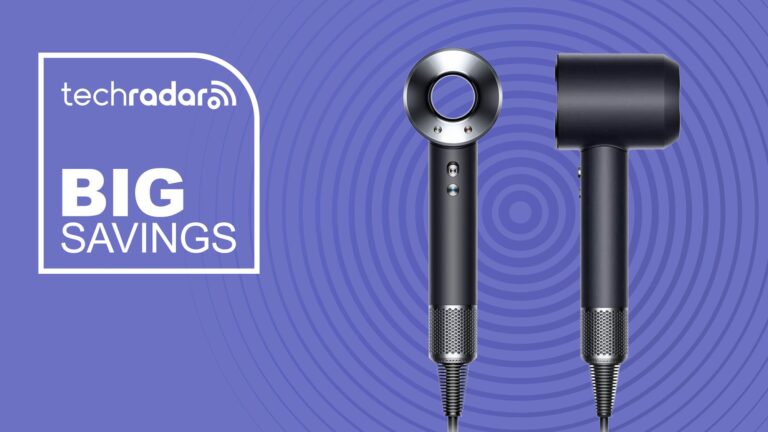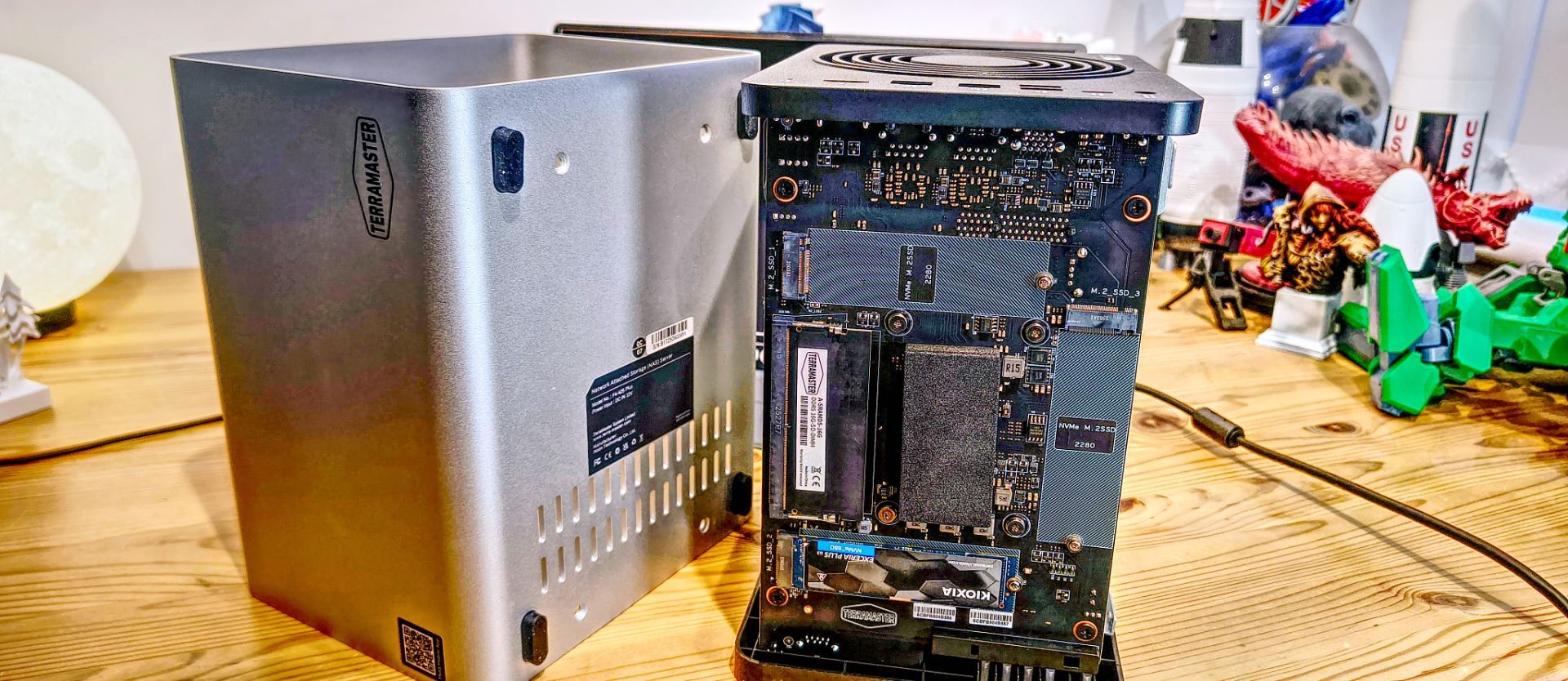
Why you can trust TechRadar
We spend hours testing every product or service we review, so you can be sure you’re buying the best. Find out more about how we test.
TerraMaster F4-425 Plus NAS: 30-second review
Terramaster has built a decent reputation by offering solid, dependable NAS solutions at a price below the market for the included features.
The F4-425 Plus is an evolution of the F4-425, where what was a solid platform has been given even more options.
Where the base F4-425 sported only four hard drive bays, the Plus model adds three M.2 slots, creating a hybrid solution that lets you mix conventional spinning rust with solid-state storage for greater performance when required.
With four 3.5/2.5 SATA slots, the total conventional storage available is 120TB with 30TB drives, and the M.2 slots enable another 24TB of NVMe storage.
The M.2 drives can be used for storage or to cache the read and write performance of the conventional drives. And with three drives, you can create a fast storage pool from all three, with redundancy.
Having fast storage is useful for local applications, but this NAS also has dual 5GbE LAN ports, allowing it to deliver at least 1,000Mb/s of data across the network, either split across the two LAN ports or via aggregation.
As with all TerraMaster’s current NAS, this system runs TOS 6.0, a full-featured operating system with a BTRFS file system and sophisticated anti-ransomware features such as WORM partitions. TerraMaster has also created a well-stocked selection of applications to install, including practical tools for a wide range of uses.
The weaknesses of this design are that it comes with 16GB of non-ECC memory, and that’s the most it will ever have, due to CPU limitations. And, the lack of PCIe lanes in this level of Intel platform has precluded USB4 or Thunderbolt ports. However, it has plenty of USB 3.2 Gen 2 ports, which is good for sharing externally attached storage.
Overall, this machine is better than the stock F4-425, but there are other four-bay NAS, like the TerraMaster F4-424 Max, that overshadow it in performance and connectivity. And, because of that, it probably won’t make our best NAS selection.
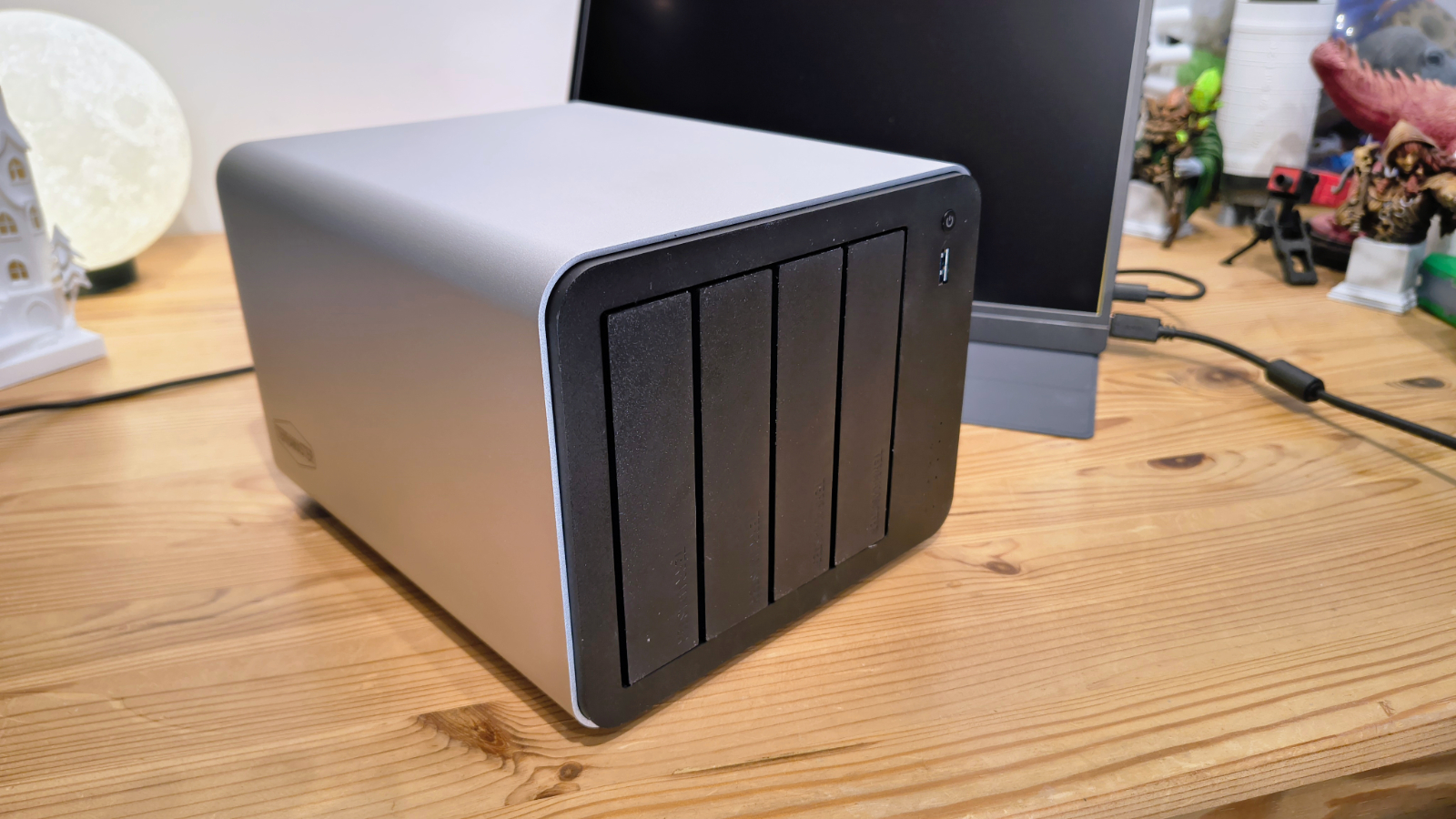
TerraMaster F4-425 Plus NAS: Price and availability
- How much does it cost? From $570£520
- When is it out? Available now
- Where can you get it? Direct from the makers or through an online retailer
At the time of writing, we’re on the cusp of this hardware being launched, and therefore, many of the retail options that should be available by the time you read this are not all in place.
For US customers, the machine is listed on NewEgg and Amazon for $569.99. The UK cost is £519.99 on Amazon.co.uk.
When you compare that to the base F4-425, which sells for $369.99 on Amazon.com, that’s a $200 bump. However, the base model only comes with 4GB of RAM, not 16GB, has a slower CPU, older memory technology and slower LAN ports.
The real issue here isn’t the base F4-425, but the Ugreen NASync DXP4800 Plus. This is only $100 more than the F4-425 Plus, but it has a much better CPU, the potential for more RAM, lockable drive trays, Thunderbolt ports and a 10GbE LAN port.
That makes the F4-424 Plus look slightly expensive, especially when you compare its build quality to that of the Ugreen NAS, which is exceptionally well designed and built.
Alternatively, TerraMaster has the F4-424 Max NAS and sells it for $900 with a similar spec to the Ugreen DXP4800 Plus, which again seems overpriced.
That same machine is only £615 in the UK, so it appears that TerraMaster is, unsurprisingly, passing on US tariffs to its American customers, while Europeans don’t get lumbered with them.
In summary, this NAS isn’t as cheap as we’ve come to expect from TerraMaster, but that might not entirely be its fault.
The official launch day is today (October 21), and TerraMaster often offer a bonus discount when products first go live, so you may be able to get one cheaper than the standard pricing.
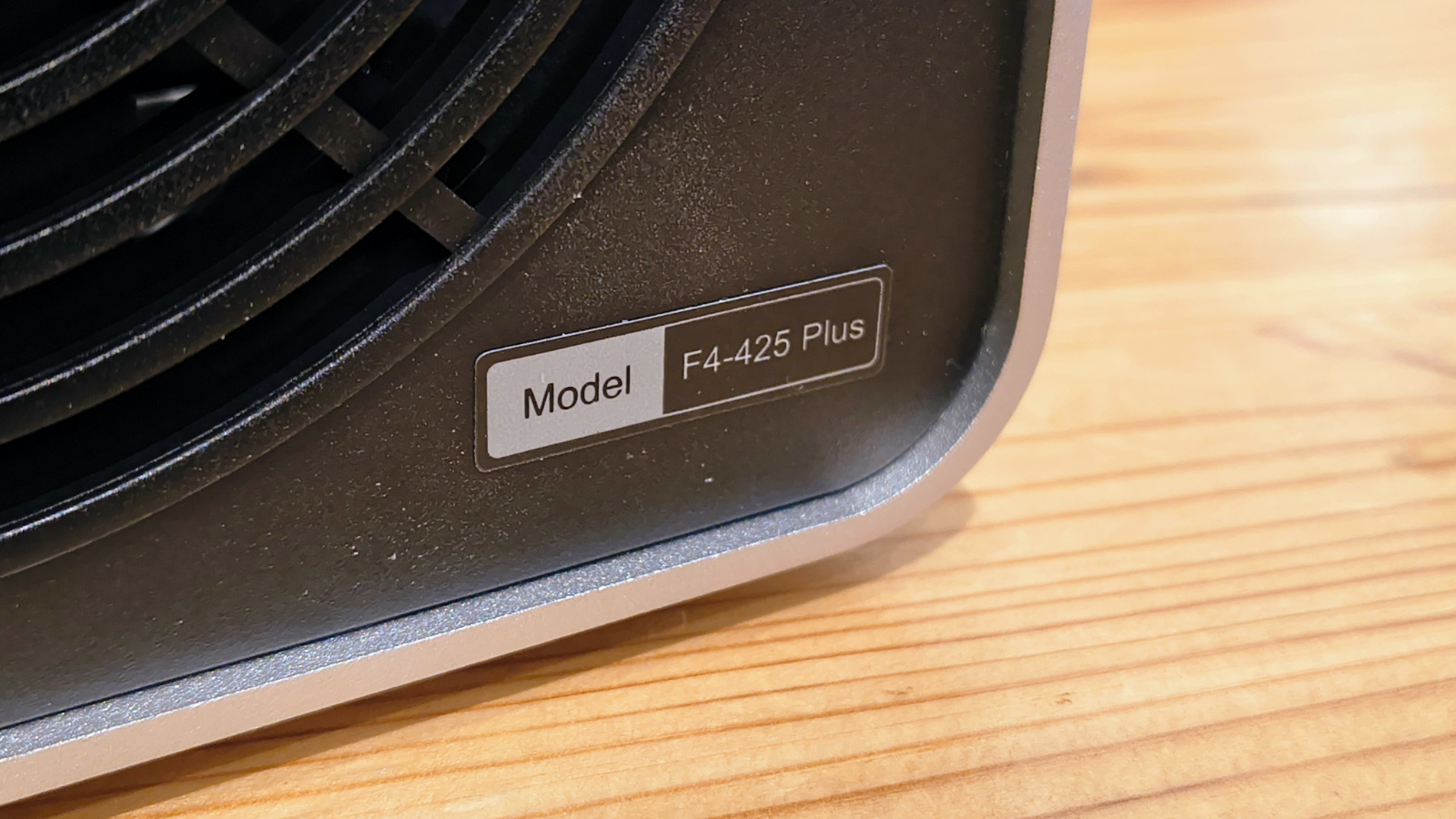
TerraMaster F4-425 Plus NAS: Specs
Item | Spec |
|---|---|
CPU: | Intel N150 (4 cores, 4 Threads) |
GPU: | Intel Graphics (24EU) |
RAM: | 16GB DDR5 not expandable |
SATA Storage: | 4x 3.5 or 2.5-inch |
M.2 Storage: | 3x M.2 NVMe PCIe 3.0 |
Ports: | 3x USB3.2 Gen2 USB-A (10Gbps) |
| Row 6 – Cell 0 | 1x USB3.2 Gen2 USB-C (10Gbps) |
| Row 7 – Cell 0 | 1x HDMI 2.0b |
Networking: | 2x RJ45 5GbE LAN |
OS: | TOS 6.0 |
Maximum Capacity: | 4x 30TB SATA + M.2 NVMe (24TB) = 144TB |
RAID Modes: | TRAID, TRAID?, Single, JBOD, RAID 0, RAID 1, RAID5, RAID 6, RAID 10 |
PSU: | 12V 7.5A 90W |
Dimensions: | 138 x 60 x 140 mm (LxWxH) |
Weight: | 2900g |
TerraMaster F4-425 Plus NAS: Design
- TerraMaster simplicity
- No tray numbering
- Dismantle for M.2 install
As a NAS builder, TerraMaster has always taken a direct, cost-effective approach to product development, and the F4-425 Plus is no exception.
This hardware is a slightly unusual combination of the old, silver TerraMaster era and the newer black motif that was introduced a few years back.
The entire exterior is a 1.2mm-thick aluminium tube that’s been laser-cut with slots, and inside that is a preseed steel cradle with a plastic front fascia.
The conventional drive trays provided are both a strength and a weakness. They take 3.5-inch drives without tools, but require plenty of screws for those who want to use a 2.5-inch mechanism.
A few aspects of these plastic trays I don’t care for. Firstly, one of those is that they’re not lockable, enabling curious fingers to accidentally remove a running hardware in mid-operation. That’s not great, and the lack of physical drive numbering on the tray is also disappointing. The makers took the time to put “TerraMaster” on the tray end, but couldn’t put 1,2,3 and 4?
There are numbers above each slot, but not on the trays. Should you remove all the drives, you might easily forget which drive goes in a particular slot. Yes, TOS should work it out as long as you put them all back, and they give you some stickers to place on the drives. But numbered trays — too much to ask?
My other gripe is that while other NAS makers can offer removable panels for memory and M.2 upgrades, TerraMaster decided the best policy was to have the owner remove the entire exterior. It’s not a big deal —just four screws —and it lifts off without any problems, but I did notice one drawback. With the thick metal case tube offering plenty of heat dissipation potential, it’s a shame that, in this design, it isn’t possible to use thermal transfer pads to connect the M.2 drives to that outer shell.
My immediate reaction to noticing this was that the designers aren’t expecting the M.2 drives to get hot, and the reason is probably the limited bandwidth per slot.
More about that thinking later.
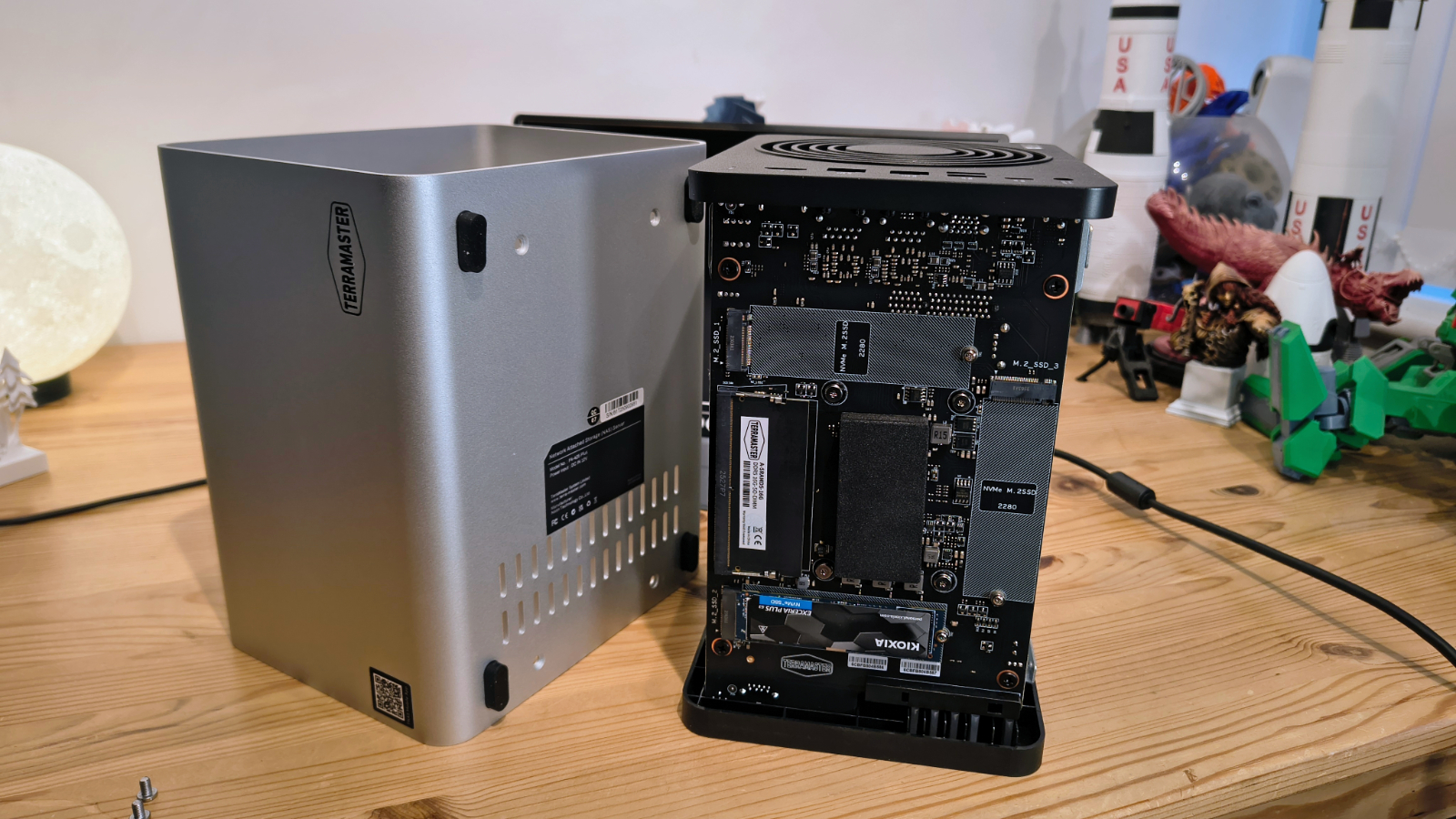
There were two other things about this design I didn’t care for. And the first of those was that TerraMaster created large rubber feet for it, but used cheap double-sided adhesive tape to attach them to the case. First one detached, then another, in most Autumnal fashion.
Better tape and a deeper recess for them to sit would help this, because the way they reduced operational vibration when attached was impressive.
The second point was that at this price point, most customers would expect USB4/Thunderbolt, but based on the Intel platform chosen, that’s not a realistic option. The USB is Gen 2, but since the main competitor products have at least one USB4 port, this machine isn’t great from a peripherals perspective.
TerraMaster F4-425 Plus NAS: Features
- Intel N150 CPU
- No ECC memory
- 9 PCIe Lanes
Looking back at the base F4-425, that machine used the Intel Celeron N5095 CPU and came with 4GB non-ECC DDR4 memory, which could be upgraded to a maximum of 16GB.
The Plus model gets an upgrade on both those counts, with an Intel N150 CPU and DDR5 memory.
The N150 is a much newer Twin Lake design released early in 2025, whereas the N5095 is a 2021 part that came on the Jasper Lake revision.
They were both designed with a low TDP and high power efficiency, but the N150 is made on a 7nm chip process, where the older N5095 used the ancient 10nm Intel process, making it less efficient. The N150 is also clocked higher, has larger L2 and L3 caches and ,
These changes manifest in the N150 having stronger multi-core performance, useful for a NAS, better graphics, and, critically, DDR5 support. But, curiously, DDR5 doesn’t offer a bandwidth boost over DDR4 in a single-stick comparison, and there is still no ECC option. That’s a dealbreaker for some.
In many respects, the differences are less impressive, as this is still a four-core CPU without hyper threading. It only gets one extra PCIe lane, going up from the eight PCIe 3.0 lanes on the N5095 to nine on the N150. That’s a maximum of 8.9GB/s to share among the peripherals, and the extra 1GB/s over the chip in the base F4-425 is all the extra bandwidth to support the three M.2 drives and the dual 5GB/s LAN ports.
But that comment assumes that the 7.9GB/s of the N5095 was fully utilised in the F4-425, and that might not be the case.
In whatever way these numbers are arranged, the port and slot arrangement of this NAS exceeds the total available bandwidth of the N150, and either TerraMaster has used a PCIe switching chip in this unit, or with lots attached, there will be bandwidth starvation.
As my performance testing revealed, the M.2 slots on this NAS don’t deliver the same performance as those on a PC, or even close.
In my testing, a Kioxia Exceria Plus G3, rated at 5,000 MB/s, achieved only 824 MB/s in benchmark testing. That hints that each M.2 only gets a single channel of PCIe 3.0, or maybe even less than that much.
When you consider that four hard drives used in an array could deliver 600-800MB/s of throughput, using the M.2 for caching might not be as useful as you might have assumed.
Realistically, regardless of how this NAS is configured, a throughput of around 1,000 MB/s across the two 5 GB/s LAN ports is probably the maximum achievable performance, even if you open up more bandwidth using USB LAN adapters.
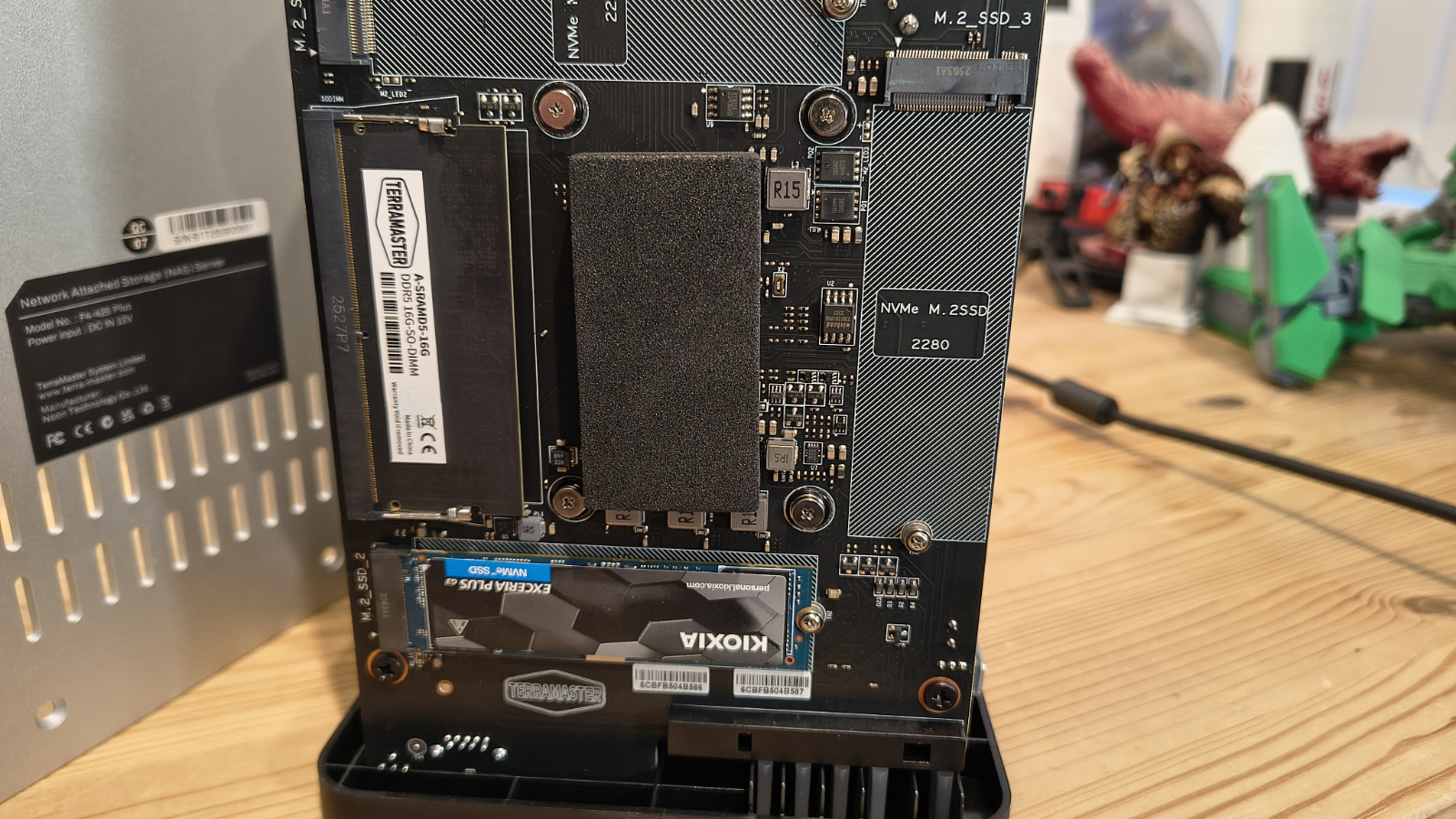
There is a way to fix most of these issues and add Thunderbolt ports: the Intel Core i5 1235U, which TerraMaster used in the F4-424 Max and Ugreen deployed on the DXP4800 Plus.
It was the obvious answer, but presumably because TerraMaster didn’t want to hit sales of the F4-424 Max, they decided against using that more expensive CPU here.
My overall impression is that the platform choice here put the F4-425 Plus between a rock and a hard place. It wants to be so much more, but with 9 PCIe lanes, there are limits that this hardware collides with.
It’s certainly better than the stock F4-425, but that’s not exactly an endorsement. The positive aspect of this story is that in the F4-425 series, TerraMaster has moved away from using ARM SoCs, and therefore, it can concentrate development of TOS on X86 hardware moving forward.
The issue here is that the Intel N150 wasn’t explicitly made for this use case. It was made for inexpensive laptops or Chromebooks with limited external ports, which significantly limits what this device can do.
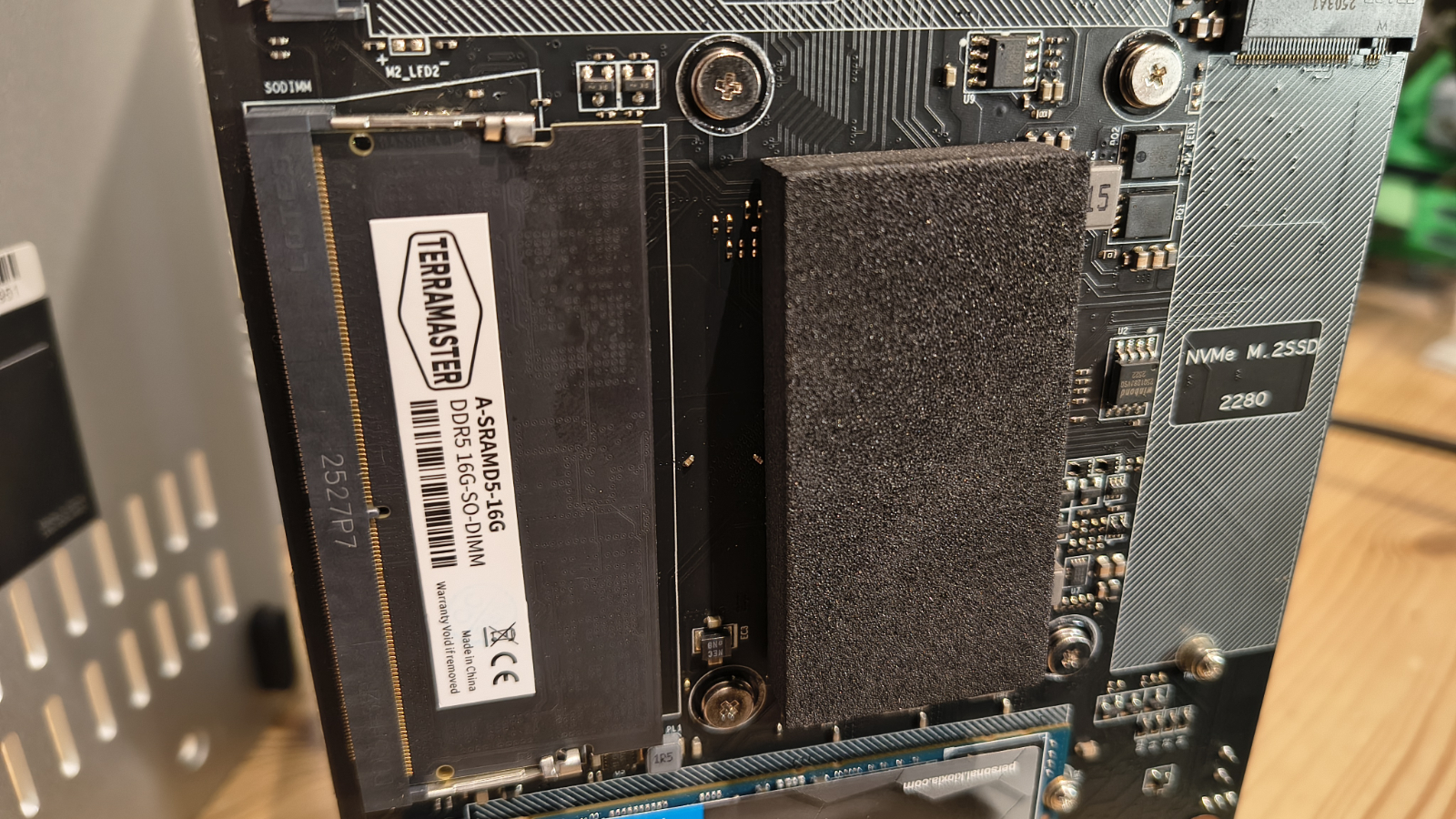
TerraMaster F4-425 Plus NAS: Software
- TOS 6.0
- Applications
- Yes to TrueNAS and UnRaid
While TOS is a significant improvement over prior releases, there are still a few oddities to this release that people need to watch out for.
One I ran smack into when I preinstalled four 4TB Seagate Iron Wolf SATA drives and a single M.2 NVMe drive, and then initialised the system.
TOS 6.0 offered me an automated configuration, which I accepted, expecting it to use the four hard drives to create a TRAID pack, yielding about 11TB with redundancy.
But instead, after a 950-minute synchronisation, I realised that it had combined the four hard drives and the 1TB SSD into an 11.5TB pack.
Therefore, taking the automated route meant that I was forced to manually repeat the storage configuration and then allocate the SSD as a cache drive.
Admittedly, with the cache active, it seemed to speed up synchronisation, but I’d recommend users to go the manual route and get the system ready for use more quickly.
One positive change I noticed from creating the cache is that you can now use read/write caching on a single drive, whereas previously, and on other NAS, you had to allocate two SSDs —one for reading and one for writing.
TOS 5.0 is also well configured to handle some standard peripherals that can boost network potential. Recently, Ugreen sent me an adapter that converts a USB-A port into a 2.5GbE LAN port, and it worked perfectly. Ugreen also makes a more costly 5GbE adapter, but the 2.5GbE hardware costs only around $20 and adds a third LAN port for failover scenarios.
Where TOS is less wonderful are apps you might expect that are missing, the most glaring being one that allows the graphical interface to appear via the HDMI port.
Why this never appeared is a mystery, but the lack of it undermines the ability to load an office productivity tool and use it directly with a mouse and keyboard plugged in.
If you need another computer to see the display, why wouldn’t you load those tools on that system?
There is a reasonable number of first-party apps, and a healthy community selection of tools compiled for TOS. But, and this isn’t unique to TerraMaster, the application future is most certainly heading towards Docker containers, and away from hard-coded software solutions.
Those who look at the application offering and don’t see the precise tools they want also have the option to entirely miss that aspect, as TerraMaster doesn’t see the installation of other NAS operating systems as a cardinal sin.
Running TrueNAS, UnRaid, or another platform is possible on this hardware if you want the machine to contribute to an existing NAS ecosystem.
While I can’t see Synology ever agreeing to this type of flexibility, I’d be surprised if almost all the other NAS brands eventually embrace the third-party operating systems in the fullness of time.
In terms of a pecking order, TOS is still behind what Asustor, QNAP and Synology are offering, but it’s ahead of Ugreen, for now. But for the average user who wants a media distribution system, a basic server, or a backup system, this is a workable solution.
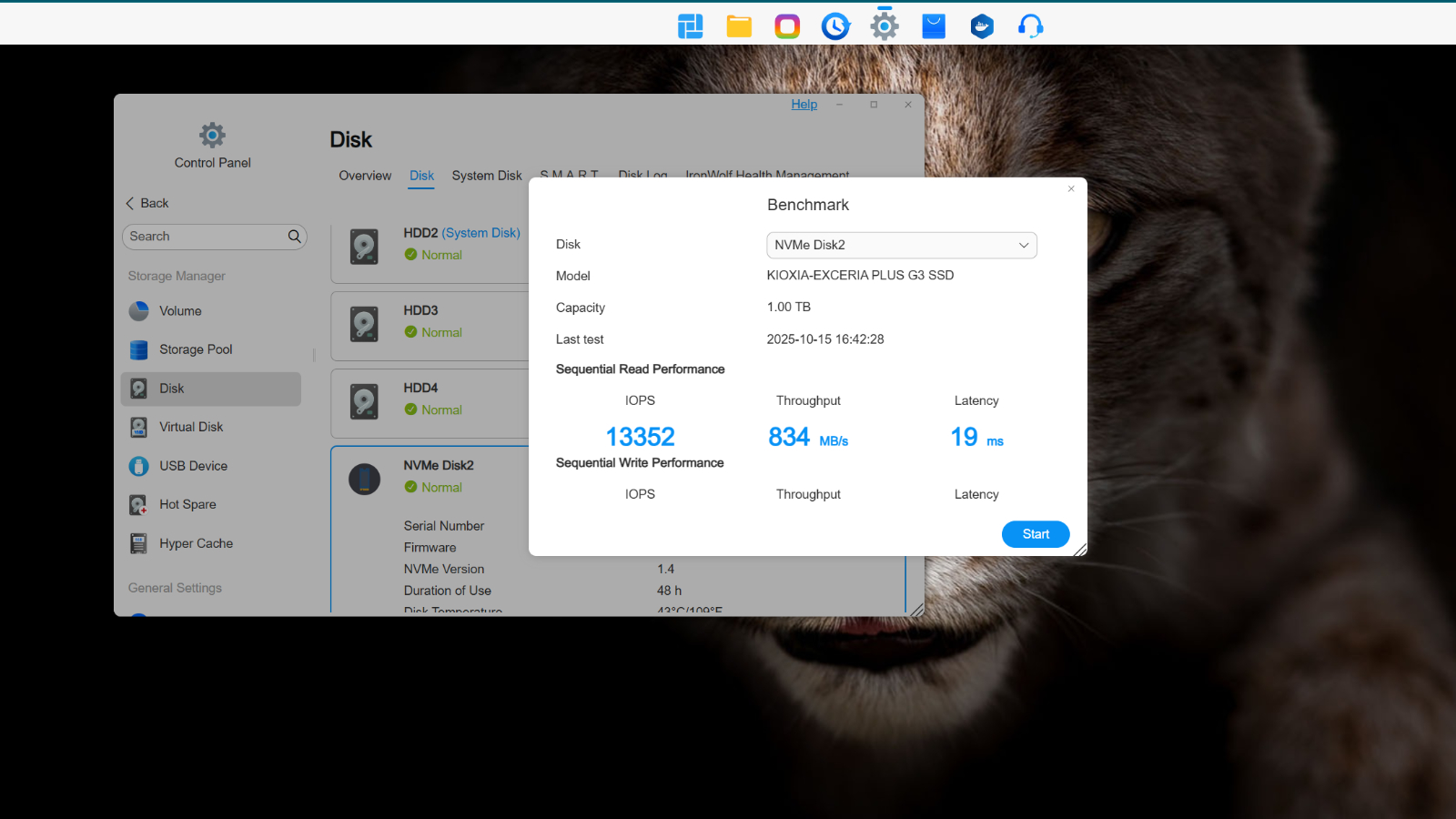
TerraMaster F4-425 Plus NAS: Final verdict
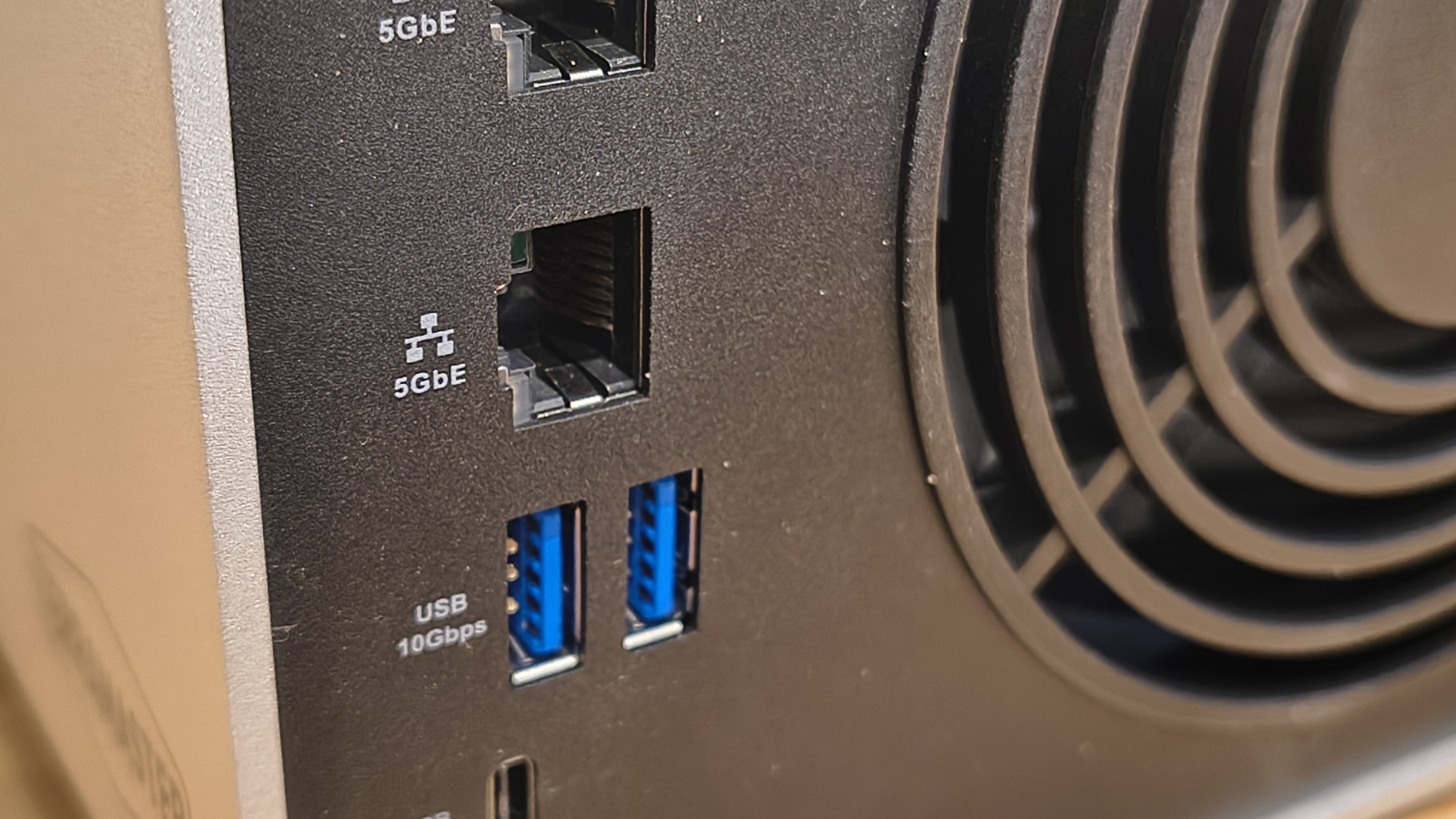
There are parts of the F4-425 Plus that I liked, and other bits that need some work. Having just reviewed the Ugreen DH4300 Plus, it’s noticeable that this NAS doesn’t have the build quality of Ugreen’s lower-priced device.
As long as it doesn’t fail, that might not be an issue, but TerraMaster should be looking over its shoulder at Ugreen, as should everyone in the NAS space.
With TerraMaster also making base, plus, and max models, there seems to be an explosion of model options, with features often overlapping.
With more hardware, the niches each perfectly addresses become smaller, and I have the feeling that the F4-425 Plus falls into a narrow strip between those who just want four drives for capacity and redundancy and those who want a silent solution built around NVMe storage. This NAS sit a little uncomfortably between those islands, and the limiting component here is undoubtedly the Intel N150.
Without Thunderbolt, you can’t directly interface with a host PC and get 40Gbps transfers, and you can’t use some of the better external RAID storage options.
Customers spending this much on a NAS before drives are added are expecting features like Thunderbolt, which didn’t make this cut.
There is also something about a design that didn’t properly address simple problems like sticking the feet on, which might suggest this design was rushed to market — something that TerraMaster typically doesn’t do.
This design is much better than the stock F4-425, but there are four-bay NAS that cost only a little more that deliver more power and features.
Should I buy a TerraMaster F4-425 Plus NAS?
Value | Not cheap for a four-bay NAS, even if its a hybrid | 3.5 / 5 |
Design | Solid aluminium case, but the feet fell off | 3,5 / 5 |
Features | Dual 5GbE LAN, 16GB of RAM, but only a four-core CPU and no ECC | 3 / 5 |
Software | TOS 6 has plenty to like | 4 / 5 |
Overall | Better than the stock F4-425, but hamstrung by Intel | 4 / 5 |
Buy it if…
Don’t buy it if…
Also Consider
For more storage solutions, we’ve reviewed the best NAS hard drives.

